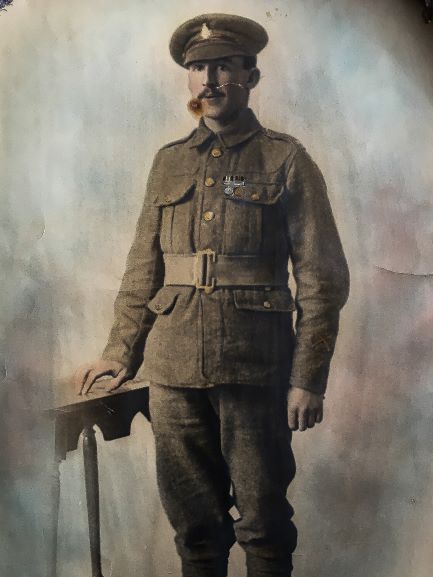
Information submitted by Lynne Pengelly.
Thomas William Tidyman known as Bill (although this may have only been after he moved to Bradford)
Born 1st November 1896 in Norton, Stockton on Tees the 2nd child, eldest son of John and Mary Tidyman
The 1911 census shows him living and working on a farm in Agglethorpe (possibly Brecongill) with his parents and 6 siblings, his older sister is listed as a diarymaid.
He enlisted on 24th May 1918 at the age of 23 into the 9th battalion of the Yorkshire Regiment and was wounded by a gunshot in his right forearm sometime in September 1918, he was transferred to the Bangour War hospital in Edinburgh and was discharged on 19th June 1919.
Carl at the Green Howard’s museum was able to tell me that my grandad had been a marksman when he saw the badge on his uniform and also explained about the silver war badge given to injured men to wear after they had been discharged as unfit for further war service.
After the war he returned to the farm his father died in 1920 and his mother died in 1927, at sometime he met my grandma who was visiting some friends who had relocated to Coverdale and they were married in Bradford on 7th December 1929.
He was a tenant farmer at Harrop Edge Farm in Allerton Bradford until 1942 and then the family moved to Allerton village and he had a milk round. He worked for the War Ag during World War 2.
He had several other less manual jobs until his retirement in 1961 and died aged 81 in 1979.
Explore more memories from the ribbon
-
Harold Carey Matthews
Major Harold Carey Matthews was born in 1879, son of F W W Matthews, he went on to join the 4th Battalion Green Howards where he acted as subaltern during the Second Boer War. After retiring from the military he worked for Barclays Bank at Leyburn, where his father also worked. When World War One broke out he re-enlisted with the Green Howards and was promoted to Major, on 29th August 1914. He was killed in action on the 25th April 1915 near Ypres and is buried at Sanctuary Wood Cemetery, Belgium.
-
John M Osborne
John Malcolm Osborne, submitter Jackie Wilson’s father, was born on 14th October 1888 to Frederick Osborne and Lydia Lindridge in Goudhurst Kent, having 7 siblings. In 1911 he was living at home in Goudhurst, Kent working as a motor mechanic. During the First World War he joined the Royal Naval Air Service on the 22nd October 1915 with the service numbers of 208815 and F 8815, before the creation of the Royal Air Force by the merger of the RNAS and the Royal Flying Corps on 1 April 1918. His papers record that he was five feet seven and a half inches tall, had brown hair and grey eyes, with a fresh complexion. He was stationed at President II, a shore based depot at White City, London. When called to a Zeppelin crash site, John removed the propeller as a souvenir. At a later date the propeller was fashioned into a walking stick. A clock was also made from the remains of the propeller, owned by Jackie’s Godfather. John Osborne was transferred to the reserve in April 1919 and discharged April 1920. John married Florence Huddlestone in Shepherd’s Bush, London, 3rd March 1918. In the 1930s he lived in Hammersmith with his wife before they moved to Cambridge. He died on the 4th February 1953 at Chesterton Hospital, Cambridge, leaving effects of £224 14s 6d to his widow Florence Maud Osborne.
-
Robert Baden Powell
Submitted by Neil Duncan of the 8th Darlington (Cockerton Green) Scout Group. Lieutenant-General Robert Stephenson Smyth Baden-Powell, 1st Baron Baden-Powell, OM, GCMG, GCVO, KCB, DL was born in 1857 and had a long and illustrious military career, as well as having a profound impact on civilian life for generations of young people. Baden-Powell spent most of his military service in India and Africa where he honed his Scouting skills and began writing training manuals which would later be the basis for the Scouting Movement from 1908. One of his most famous commands was during the Seige of Mafeking in 1899 when a small garrison held out for 277 days and a ‘Cadet Force’ was drawn up take over small but important jobs to allow the adults to fight. These Cadets gain an honourable mention in the opening chapter of Scouting For Boys. He returned to England to take up a post as Inspector-General of Cavalry in 1903. From 1908-10 he was in command of the Northern Territorial Army. During this appointment, Baden-Powell selected the location of Catterick Garrison to replace Richmond Castle which was then the Headquarters of the Northumbrian Division. His plan was brought to fruition following the outbreak of the First World War. The original concept was for a temporary camp to accommodate 2 complete divisions, 40,000 single men in 2,000 huts. On the outbreak of World War I in 1914, at the age of fifty-seven, Baden-Powell put himself at the disposal of the War Office. Lord Kitchener…
